

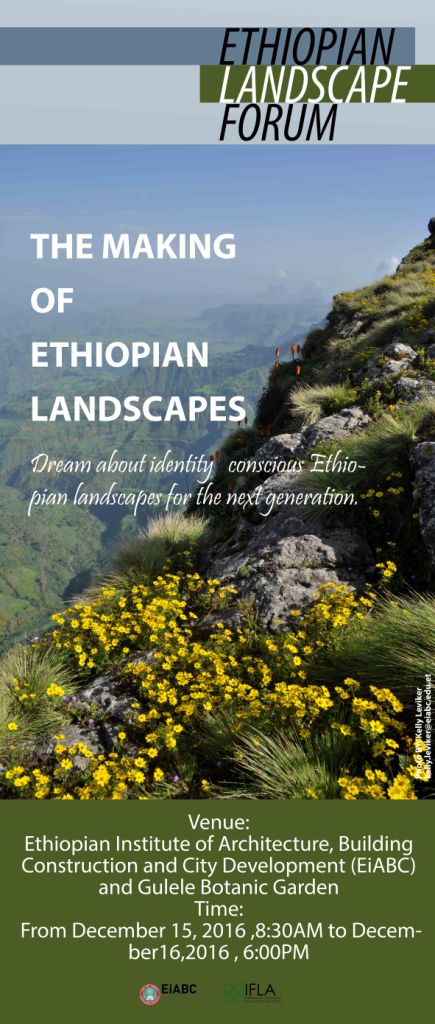
1st Ethiopian Landscape Forum together with IFLA, the International Federation of Landscape Architecture, on 15th and 16th December, 2016
The making of Ethiopian Landscapes
Thefirst quarter of the twenty-first century is threatened by three global phenomena namely the high rate of urbanization, erratic climatic anomalies and terror driven by human migration. The positive and negative impacts of their these phenomena are continually etched on global landscapes. Landscape is a spatial entity that evolved over a period of time as a result of natural and cultural processes interaction. Natural processes refer to a bio-geomorphic system, while cultural processes are the sum total of human systems grafted on the environment for economic, social, recreational, transportation, military, religious and agricultural purposes. These usages create diverse landscape features, which in turn are responsible for diverse human adaptations for survival in a bioregion. Dynamic developmental economic survival has in recent years become the destructive stripping of natural landscapes of their originality and distorting precious cultural landscapes. This is being compounded by climate change phenomenon,urbanization and environmental injustice. Global players look in the direction of UNESCOInternational Landscape Convention; United Nations Habitat III; and Conference of Parties (COP) for solutions. The later, ‘COP’, stands for 196 signatories of United Nations Framework Convention on Climate Change (UNFCCC).
Ethiopia is conscious of its urban and rural landscapes and was one of the first countries to submit its Intended Nationally Determined Contribution to the UNFCCC with interests on eveloping a green economy and meeting food security within its rapidly growing urbancentres. Though Ethiopia’s 16% urbanization seems low compared with other global south nations, the worry is what will influence our urban morphology, especially the desired public realm, green, grey and blue infrastructures? The October 1st UN Habitat III gathering in Quito, Ecuador was about an urban paradigm shift reflecting on the ‘cities we need’, This paradigm shift sees landscape as a human construct showing dialogue that occurs between human and ecological processes, as expressed in the UN 2015 Sustainable Development Goals. Our national landscape of today evolved from the decisions made in yesteryears. The decision for tomorrow’s landscapes is being made now.What type of Ethiopian urban, social, rural, academic, touristic, agricultural, forest, riverlandscapes do we want tomorrow? What intellectual capacity building do we give to Ethiopian youths that will develop, manage, and preserve these landscapes? Your opinion matters. Please join us to dream about identity conscious Ethiopian landscapes for the next generation.
Contact
Chair of Landscape Architecture
Aziza Abdulfetah, e: This email address is being protected from spambots. You need JavaScript enabled to view it. or
Kelly Leviker, e: This email address is being protected from spambots. You need JavaScript enabled to view it.
Calls: Landscape Architecture in Africa Exhibition (Professional Category)
Landscape Architecture in Africa will be a multi-media exhibition of landscape architecture works from across the continent. Works that exhibit a public impact, increase resilience and demonstrate a multidisciplinary effort are especially encouraged to participate. The works should demonstrate the potential of landscape architecture in solving pressing issues, especially within the African context.
Aim: to raise awareness of the profession and its potential amongst government officials and the public as well as for landscape architect professionals to gain a broader understanding of the professional works happening across the continent.
Submission Format: Format submission is partially open. Semi-interactive formats, such as pamphlets, videos, photo albums, innovative materials used, amongst others, are encouraged, as to engage a wider audience. Panels should be A1 Portrait. There should be either 3 or 6 panels.
Each submission should include who were the designers, city and country of the project, and a 250 maximum written description of the project.
Submission Deadline:midnight, December 9, 2016
Exhibition Output: a book, Crafting African Landscapes
Calls:Landscape Architecture in Africa Exhibition (Student Category)
Landscape Architecture in Africa will be a multi-media exhibition of landscape architecture
works from across the continent. Works that exhibit a public impact, increase resilience and demonstrate a multidisciplinary effort are especially encouraged to participate. The works should demonstrate the potential of landscape architecture in solving pressing issues,especially within the African context.
Submission Format: Format submission is partially open. Semi-interactive formats, such as pamphlets, videos, photo albums, innovative materials used, etc.,are encouraged as to engage a wider audience. Panels should be A1 Portrait. There should be either 3 or 6 panels.
Each submission should include who were the designers, city and country of the project, and a 250 maximum written description of the project.
Submission Deadline:midnight, December 9, 2016
Exhibition Output: a book, Crafting African Landscapes
Hosting Institution
EiABC, (Ethiopian Institute of Architecture, Building Construction and City Development),with its former name Building College, was established in 1954 by Emperor Haile Selassie.Currently, the institute has 3,200 registered students. The total number of staff is around 430, of which 200 are academic staff, and 230 are administrative and service staff.EiABC is an autonomous Institute of Technology under Addis Ababa University, offering programs related to the built environment at the Bachelor, Master and PhD level. EiABC has become a leader in excellent education, applied research as well as in offering consultancy services to the industry and it, therefore, benefits to society as a whole. It offers its students, faculty, and researchers an inspiring environment and its doors
are open for all partners in the academic and applied fields of the building industry.EiABC has more than 3,000 students and offers academic opportunities with various Bachelor, Master and PhD programs. It gained a reputation as the leading Institute of Technology in the field of the built environment in East Africa and it is continuing to offer new chances, study opportunities, and research possibilities to all its students, faculty, and national as well as international partners.
Master of Landscape Architecture
The Chair of Landscape Architecture was formed in 2014, when it branched out from the Chair of Environmental Planning. For its first year, it focused on aspects of landscape architecture within the Master of Environmental Planning and Landscape Design and individual landscape architecture classes within the undergraduate architecture program.
In September 2015, we launched the Master of Landscape Architecture. It is a two-year program and is the first program dedicated fully to the profession of landscape architecture within Ethiopia as well as within the Horn of Africa. As the program and profession establishes itself, the program will have a particularly practical nature, as the program is also about how to establish a profession. Once, the profession and program are more established, the program will acquire a more theoretical nature.
Besides teaching, the other objectives of the Chair are to complete research and to serve within and create community outreach programs. This semester our Chair is involved with two community outreach programs. The first program is being completed together with an organization called Out of the Box. Our students together with this organization and students from other chairs are designing and building a playground within a condominium development which previously was designed without a space to accommodate children.The second project which serves as both a research and community outreach project was the design and on-going research of a roof garden and suitable roof garden plants for the Horn of Africa Regional Environment Centre and Network headquarters building.
Addis Ababa
The relatively new capital of Ethiopia, Addis Ababa, was first established in 1886 by King Menelik and Queen ‘Taitu. The discovery of fast-growing Eucalyptus trees, bahir zef,allowed for an adequate supplies of firewood and enabled a transition from a nation with roaming capitals to a settled capital. Addis Ababa, new flower, is the only African capital that was not colonized and, thus, the only African capital with an indigenous settlement pattern.
Now, it is known as not only the capital city of Ethiopia, but the diplomatic capital of Africa, with the headquarters of the African Union, United National Economic Commission as well as the regional (African) office of the United Nations Development Programme. It is the fourth highest capital city in the world with elevations ranging from 2136 to 3197 meters as well as the fourth largest city in Africa. Despite being a capital city, the city is known for being relatively safe. It is the stage upon which a fast-paced modernization process is being enacted. The built form of the city consists of a stark contrast between sky scrapers competing for height and traditional neighborhoods. There are no multinational companies that dot the landscape and just by arriving on Ethiopian soil you will be seven years younger! Ethiopian uses its own calendar, similar to the Julian or Coptic calendar, which is seven–eight years behind the Gregorian calendar and includes 13 months. From this, Ethiopia is sometimes captioned as a country with ’13 months of Sunshine’.
Sites to see in Addis Ababa: The Ethnological Museum (within the former palace of Emperor Haile Selassie), National Museum (with Lucy), St. George Cathedral, ‘Red Terror’ Martyrs museum, Merkato (largest outdoor market in Africa), Holy Trinity Cathedral, Addis Ababa museum, Entoto mountains, traditional ‘azmari betoch’ (establishments hosting traditional singing, mixed with poetry, and dancing).
Ethiopia
Ethiopia is known as the water tower of Africa, as it hosts fourteen rivers that descend from its mountainous terrain. One of theses rivers is one of the two sources of the Nile. Besides some of the highest elevations in Africa, there is the Danakil Depression, which is one of the lowest points on earth at 125 meters below sea level. Within the Danakil Depression is Erta Ale, which is one world’s oldest active lava lakes. This is in the Afar triangle, where the East-African Rift Valley begins, which will one day separate Africa into two. The Rift Valley runs from the Red Sea through the middle of Ethiopia down into Mozambique.
Nikoli Vavilov named Ethiopia as a biodiversity hotspot as well as the centre of origin for many cultivated, cereal crops, during his visits to the country in 1927. Ethiopia helped him to develop his theory the plants were domesticated not at random, but there were centres of domestication. There are now around 6,000 known species within the country, of which 10–12% are endemic.
Ethiopia is home to one of the oldest known humans ‘Lucy’, Australopithecus afarensis,named after where she was found, Afar. It is the oldest independent country in Africa and it also was one of the first nations to accept Christianity as a state religion. In addition, the then kingdom of Aksum accepted some of the first followers of the Prophet Mohammed, thus some of the first Muslims, who were being persecuted in Mecca. The country has a long history of religious tolerance and co-mingling. There are nine UNESCO-listed world heritage sites (Lalibela, Negash village, Semien Mountains, Harar, Aksum, Fasil Ghebbi in Gondar, the cultural landscapes in Konso, Awash lower valley, and Tiya) in Ethiopia. There are over 80 ethnic groups within the country and it is one of the least urbanized countries in the world. In 2015, Ethiopia was awarded as the best tourist destination by the European Council on Tourism and Trade.
Places to see in Ethiopia: Simien Mountains, Lake Tana, Blue Niles Falls, Harar, Omo National Park, Aksum (supposedly the location of the Ark of the Covenant), coffee forests,Lalibela, Danakil Depression, amongst many others.
click Here to download IFLA Schedule.
Ethio-Steel PLC is a foreign owned roof sheeting company established in 1997. It is a leading manufacturer of steel roofing sheets and accessories. Anbessa, Resincot, Versatile, Zentile are some of the brands the company is producing for the local market.
 Agreement signing ceremony between EiABC and Ethio-Steel PlC
Agreement signing ceremony between EiABC and Ethio-Steel PlC
An agreement has been signed between EiABC's Scientific Director, Mr. Joachim Dieter and a representative of Ethio-Steel Mr. Tamrat Tere. On the occasion of the ceremony Joachim said one of the missions of our institution is to work closely with different organizations to produce skilled manpower, which will benefit the demands of the industry. Joachim added that there is a great interest in working closely with similar companies to enhance industry linkage through the transfer of technology.
The representative of Ethio-Steel Plc Mr. Tamrat said that on their 20th year anniversary, they are glad to make such an agreement which in the future will help them to work together closely on various activities. According to the agreement made between the two partners Ethio-Steel Plc is going to give a monthly financial support of 1,000 Ethiopian birr per month to 24 low income students for the period of one year.
Such an agreement shall help and motivate those students who are in a difficult financial situation and shall enable them to fully focus on their education and academic career.
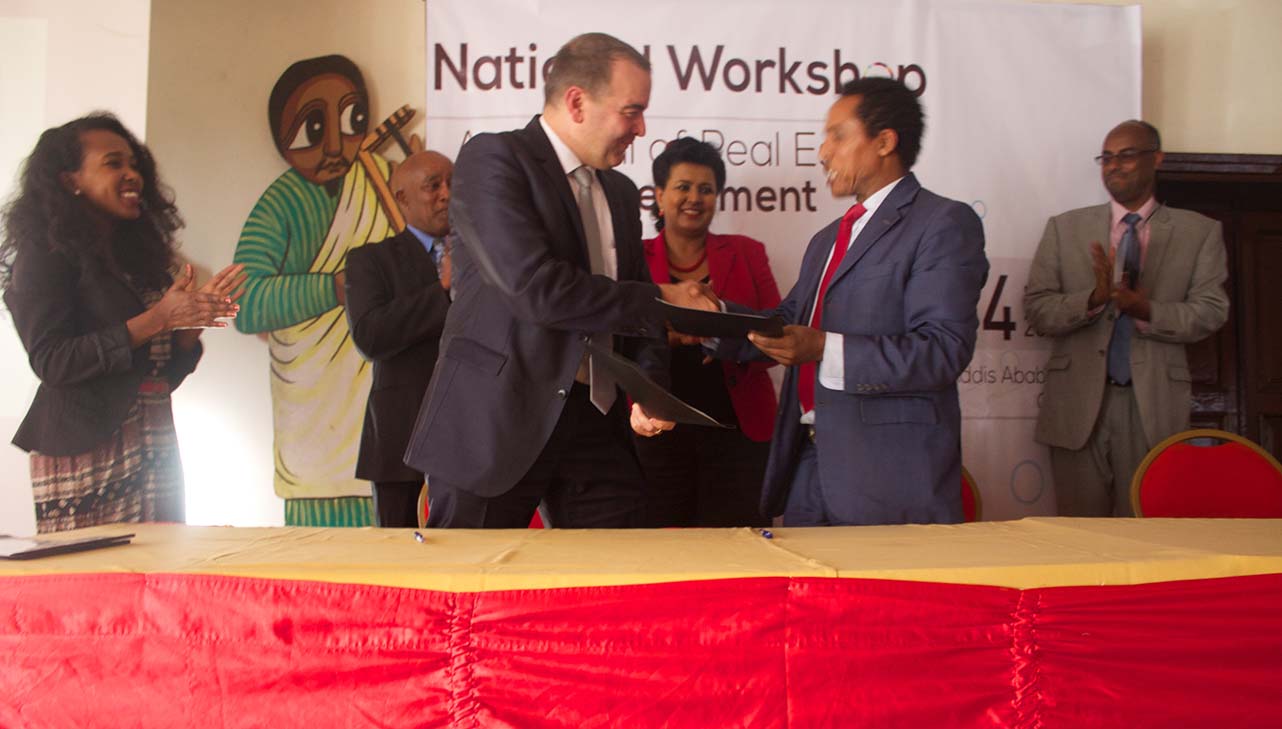
On November 24, 2015 EiABC conducted a national workshop with the theme "Appraisal of Real Estate Development". The workshop was aimed at creating awareness on sustainable real estate development in Ethiopia and providing a platform for all stakeholders to discuss opportunities, challenges and prospects in the sector.The event took place in Ghion Hotel and was attended by representatives of Real estate companies, government offices, financial institutions, higher education institutions, construction companies, NGOs, Consulting firms and individual contractors.
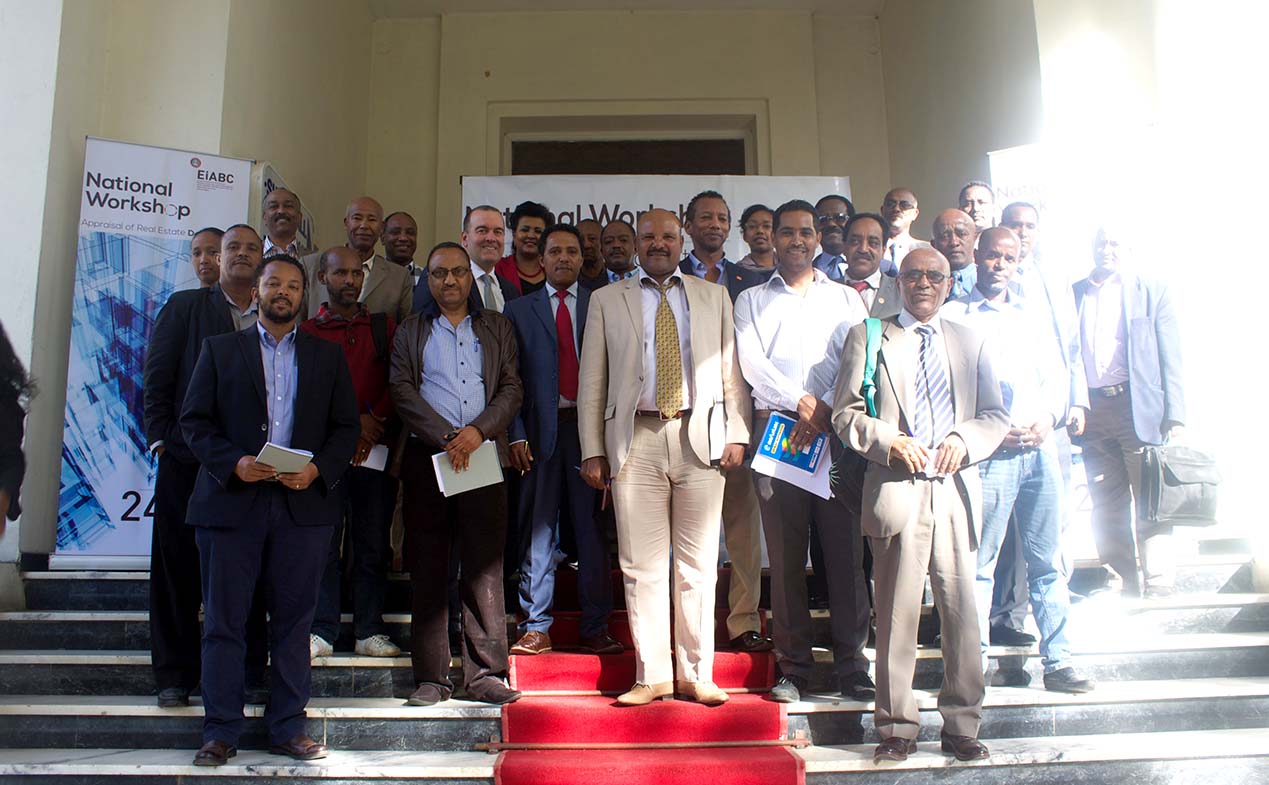 The workshop was opened with keynote speech by Mr. Joachim Dieter, the scientific director of EiABC, which was followed with a speech from a representative of Ministry of Urban Development, Housing and Construction.
The workshop was opened with keynote speech by Mr. Joachim Dieter, the scientific director of EiABC, which was followed with a speech from a representative of Ministry of Urban Development, Housing and Construction.
Various presentations and discussions were made on issues related to opportunities, challenges and prospects of real estate development. These include a presentation on Ethiopian real estate policy perspective by a representative of Ministry of Urban Development, Housing and Construction, private real estate development challenges and prospects, public real estate development challenges and prospects and real estate business perspectives. The workshop was closed by signing of Memorandum of Understanding between EiABC and four institutions namely MAY real estate, Flintstone Engineering, Saint Mary's University and ETG Designers and Consultants plc. This workshop was made possible by the effort of the EiABC AFRES organizing committee.
After receiving 436 bond certificates through MoFED, which represents 100% of our administrative and academic staff, it was just the past Friday 4th of December 2015; our own campus EiABC had hand-over ceremony of "Grand Ethiopian Renaissance Dam Bond" starting 2:30pm, at the EIABC sports field. On this hand-over ceremony Dr. Admasu Tsegaye, President of Addis Ababa University and other AAU officials were present. Also around 220 administrative and academic EiABC staffs were present.
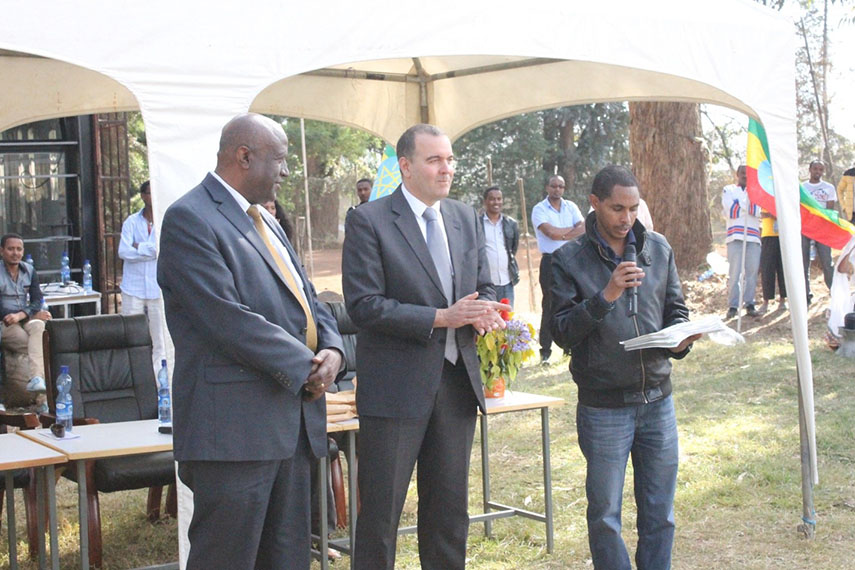
From left to right [ Dr Admasu Tsegaye AAU President, Professor Joachim Dieter Scientific Director of EiABC and Ato Ataklti Abrha A/Managing Director of EiABC
At the "Grand Ethiopian Renaissance Dam Bond" hand-over ceremony
The program begun by welcoming Dr. Admasu Tsegaye to EiABC campus by EiABC Scientific Director Professor Joachim Dieter and Acting Managing Director Ataklti Abrha and other head of units. As the first part of the program was visit around the campus, the visiting team went to visit the new datacenter /ICT project. All officials from AAU were really impressed with this big infrastructure project, as it is a very huge investment which is going to provide sustainable, timely and accurate services, advice, information and training in the areas of Information and Communication Technology to support and inform effective and efficient teaching, learning, research and management of the institute.
The visit continued to the campus clinic which was an example of standardization and customer centricity. This visit led to the new canteen kitchen of EiABC students. Even though this project was started almost more than 3 years ago, it was a living evidence of how the institute cares about providing a standard and quality service to its students. Professor Joachim Dieter also has explained that this kitchen was built with the effort of EiABC's own different offices such as ICT, facility management and so on.
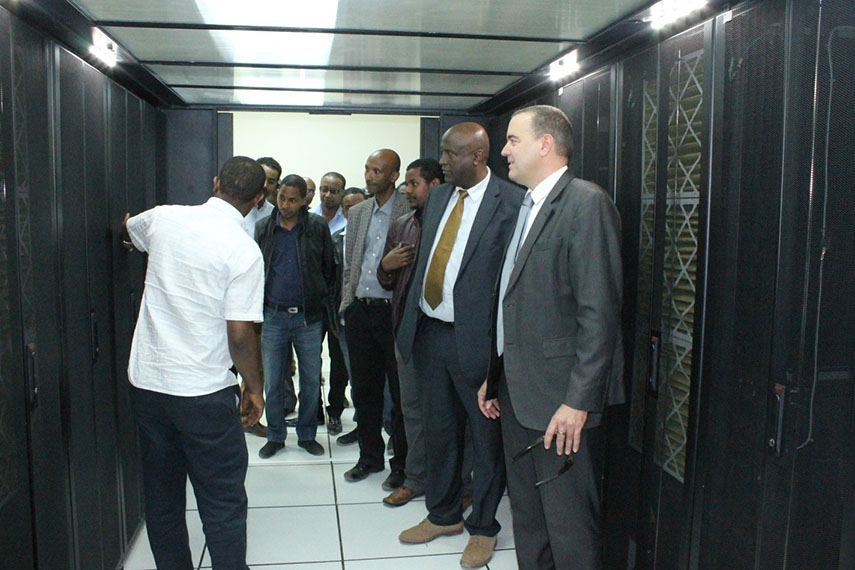
Team visiting the new datacenter /ICT infrastructure project
The team finally passed by to visit the "EiABC Entrance Gate and Wall Design Competition" submissions on the way to the sports field before joining the Hand-over ceremony. Due to road construction, the Entrance Gate and Compound Wall need to be redesigned. This competition was a very inspiring initiative by EiABC that motivates students and staff of EiABC to leave their finger prints on the design for the entrance gate on the fence parallel to the road from Mexico to Torhailoch. This design will not only include the gate design but also the wall and shops that will emphasize the original gate on Smuts street and the Dej. Baltcha Nefso St. (Coca street).
At the bond giving ceremony, almost 10-15 staff have received their certificates from the hand of Dr Admasu Tsegaye. And from the speech given by the president of AAU himself, he has appreciated the work of EiABC so far and wants to encourage other institutes in doing the same.
During the month of November from 16th to 20th, Global Entrepreneurship Week was celebrated in EiABC. The objective of this event was to encourage the entrepreneurship edge and desire among the students and staff of the institution. The theme for the event was "Entrepreneurship for a better Ethiopia." The program was organized by the Center for Entrepreneurship of EiABC, with the initiation of Ato Brihanu, the Director of the Center.
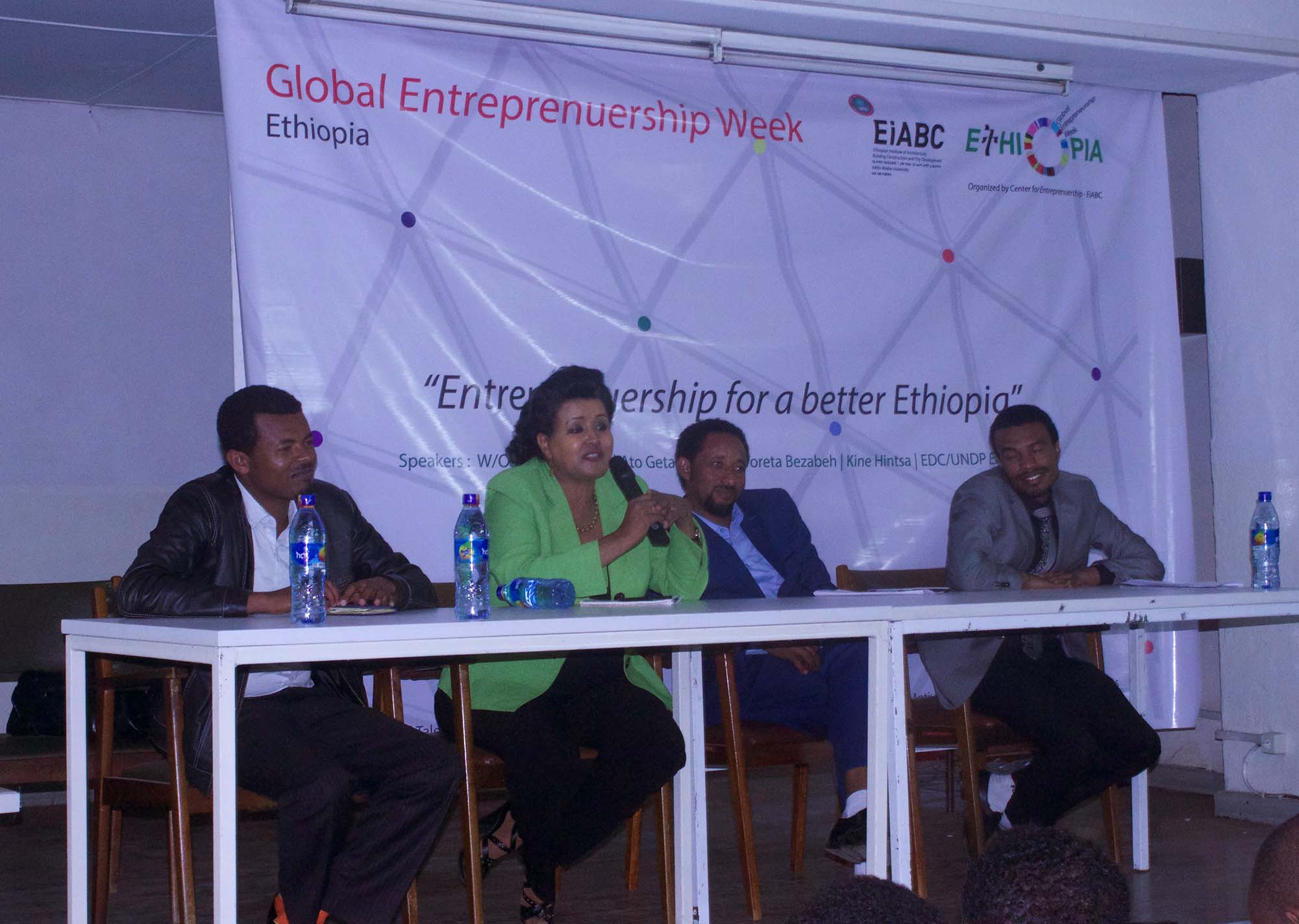
Day one was the opening of the event. Joachim Dieter, Scientific Director of our esteemed campus, delivered the Opening Speech. There was a space for experience sharing where representatives from various partner organizations were present, some of whom include Ato Nurbasse from the Entrepreneurship Development Center, Ato Ashenafi owner of Garment Business and W/o Mulu Solomon a staff of EiABC and a renowned woman.
Day two was a day scheduled for sporting activities among the students. It was a continuation of a running football tournament concerning all the faculties. Day three involved a presentation on Self Confidence and Self Esteem delivered by Dr. Abebaw, Director of Quality Assurance and Reform of EiABC and a second round panel discussion by Ato Nebiyu T. from the Entrepreneurship Development Center, W/o Frehiwot an Entrepreneur and Ato Nebiyu a business owner.
Day four was a day of sports where staff played football among themselves. Day five was the wrap up day were awards were presented and speeches where delivered. Among those who delivered speeches that day were Ato Getachew Biratu from Royal Hotel who also is the owner and Managing Director of Akake Garments and Dr. Werotaw Bezabih who is a trainer and consultant in the field of Entrepreneurship.
SAPE ERROR: Нет доступа на запись к файлу: C:\inetpub\wwwroot\templates\eiabc\images\cache\005e1c30997002fbe5298dd1be4e0c74/links.db! Выставите права 777 на папку.